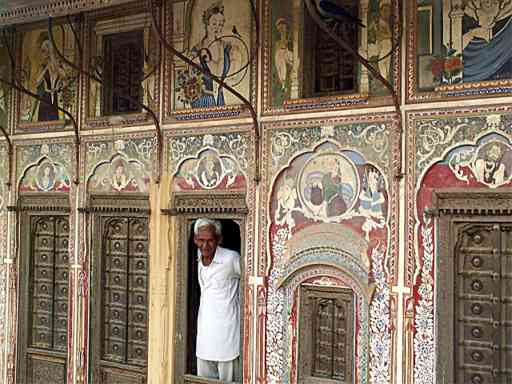![]()
The painted houses of Shekhawati
|
|
The painted houses of Shekhawati |

| Shekhawati |
| Shekhawati is a small
administrative district in the East of Rajasthan with one of the most
unusual art collections in the world. After the open air museum that is
Jaisalmer, this whole area must be the closest thing to an open air
gallery. Painted houses is one thing but how the two interesting aspects
of the painted towns of Shekhawati are their history and what they depict.
|
|
|
| The story of the murals
begins with the fading of the camel routes through Rajasthan. Initially,
the local rulers had been collecting taxes from poor farmers and imposed
duties on merchandise crossing their territory. There were caravans from
Arabian ports going to Delhi as well as East-West trade following the Silk
Road. These taxes however were never quite sufficient to fill up their
treasuries. With the British East India company, the newly built ports of
Calcutta and Bombay and their low tariffs, camel traffic through Rajasthan
was no longer viable. This should have been the end. Men from the
Shekhawati area migrated and started business in the East, most
prominently in Calcutta. These men were successful and they were followed
by many others. By the end of the 19th century, men from the Shekhawati
region were making enormous fortunes.
|
|
|
| Initially, only the most
visible parts of these houses in their home cities were decorated. Soon
any surface could be painted : outer walls, inner courtyards, bedrooms.
Competition settled in between the emigrant merchandisers and each would
compete with its neighbour for the most richly decorated house. Decoration
does not only include murals but also fine wood carving and, inside the
rooms, the painting of wooden structures. Edifices grew larger and even
temples and wells were covered with paintings. When famine struck in their
arid province, the Calcutta would send even more money back home.
"Their relief projects took the form of yet more palatial buildings
decorated with yet more paintings."
|
|
|
| The walls and ceilings in the
Shekhawati region depict all aspects of life at the turn of the century.
The obvious religious pictures and scenes of everyday life have changed
little in India over more than 100 years. The interesting pictures are
those that illustrate the modern machinery of the times such as
aeroplanes, cars and telephones. Even illustrations of historical events,
foreigners in India or important people of the time. The meeting of icons
from the East and from the West at the turn of last century.
|
|
|
| We stayed in Shekhawati, an
area of approximately for 3 days and visited the cities and villages of
Fatehpur, Jhunjhunu, Bissau, Ramgarh, Nawalgarh, Mandawa and Manhansar !
Of the several hundred pictures we took we have selected only a few of the
3 places we were most impressed by : Nawalgarh comes in first, Bissau and
Mandawa equal seconds ! These three had an incredible concentration of
painted buildings that were varied and well preserved.
|
| Nawalgarh |
|
|
|
Train carriages pulled by horses (left), foreigners and their strange habits (centre), another strange foreigner (right)
|
| Bissau |
|
|
|
|
| Mandawa |
|
|
| Modern times ! |
|
|
| The future ? |
| Most of these mansions and havelis are in everyday use. Some have turned into schools, homes or businesses. Time has taken its toll on the paintings as well as on the buildings and many need urgent restoration. Some erotic or religious paintings have been painted over or voluntarily damaged as times have changed. Several of the pictures taken above might have disappeared in less than a decade. |
|
|
We are doing well !
| Jaisalmer | Back to Trip page | Staying in palaces |